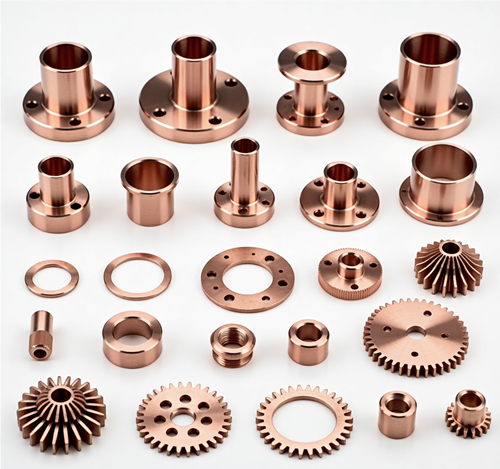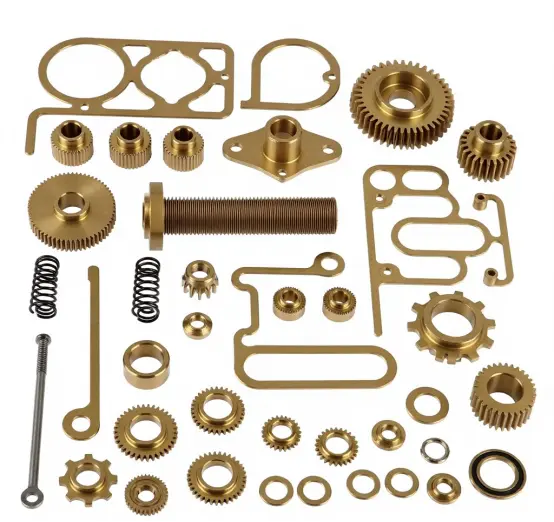
Knowledge
Common Materials for Non-standard Mechanical Design - Copper Alloys


In the field of non-standard mechanical design, copper and copper alloys (such as T2 pure copper, H62 common brass, H59 lead brass, aluminum bronze QAl9-4, white copper B30, beryllium bronze QBe2, and chromium-zirconium copper CuCrZr) have become key materials for special working conditions due to their excellent electrical conductivity, thermal conductivity, corrosion resistance and processing performance. The rational selection of copper materials can effectively meet the design requirements of electrical conduction, heat conduction, wear resistance and corrosion resistance.
I. Pure Copper Series - Experts in Conductivity and Heat Conduction
1. T2 Pure Copper
Performance Characteristics: T2 copper has a copper content of ≥99.90%, featuring excellent electrical and thermal conductivity, with an electrical conductivity reaching 100% IACS. It has excellent plasticity, making it easy to process through cold and hot pressure, but it has relatively low strength and hardness.
Common Surface Treatment Methods:
· Silver Plating: Enhances electrical conductivity and corrosion resistance
· Tin Plating: Improves solderability and prevents oxidation
· Passivation Treatment: Forms a protective film to prevent discoloration
· Painting: Insulation protection
Common Heat Treatment Methods:
· Annealing: Heat to 500-700°C and then cool rapidly
· Recrystallization Annealing: Eliminates work hardening and restores plasticity
Application scenarios: Electrical components such as wires, cables, and conductive bars; heat transfer components such as heat exchangers and radiators; corrosion-resistant equipment such as pipes and containers.
II. Brass Series - Excellent Machining Performance
1. H62 Common Brass
Performance Characteristics: H62 is an α+β dual-phase brass with good mechanical properties. It has good plasticity in the hot state and acceptable plasticity in the cold state. It has excellent machining performance and average corrosion resistance.
Common surface treatment methods:
· Nickel plating: Improves corrosion resistance and aesthetics
· Chromium plating: Enhances surface hardness and wear resistance
· Passivation treatment: Prevents dezincification corrosion
· Polishing treatment: Achieves a bright surface
Common heat treatment methods:
· Annealing: 500-650℃ to relieve stress
· Recrystallization annealing: Improves processing performance
2. H59 Leaded Brass
Performance Characteristics: H59 is a leaded brass with extremely excellent machinability, high surface finish of products, and good wear resistance and corrosion resistance.
Common surface treatment methods:
· Chrome plating: Improves surface quality
· Chemical polishing: Obtains a bright surface
· Passivation treatment: Enhances corrosion resistance
Common heat treatment methods:
· Annealing: Improves machinability
· Hot working: Hot forging temperature 650-750℃
Applicable occasions:
III. Bronze Series - The First Choice for Wear and Corrosion Resistance
1. QSn6.5-0.1 Tin Bronze
Performance Characteristics: QSn6.5-0.1 tin bronze features high strength, elasticity, and wear resistance. It has good anti-magnetic properties, excellent cold and hot working performance, good machinability, weldability, and strong corrosion resistance.
Common Surface Treatment Methods:
· Silver plating: Enhances electrical conductivity and corrosion resistance
· Chemical oxidation: Forms a protective film layer
· Polishing: Improves surface smoothness
Common Heat Treatment Methods:
· Annealing: 600-650°C to relieve stress
· Quenching + Tempering: Increases strength and elasticity
Application scenarios: Springs, contact pieces and other elastic components; gears, worm wheels and other wear-resistant parts; bearings, bushings and other wear-resistant components.
2. QAl9-4 aluminum bronze
Performance characteristics: QAl9-4 has high strength, thermal stability and corrosion resistance. It is stable below 400℃, has anti-friction properties, and can be strengthened after heat treatment.
Common surface treatment methods:
· Chemical oxidation: Form a protective film
· Painting: Special environment protection
· Polishing: Improve surface quality
Common heat treatment methods:
· Quenching: Increase strength and hardness
· Tempering: Adjust mechanical properties
Application scenarios: Important wear-resistant parts such as gears and worm wheels; corrosion-resistant components such as ship parts; high-strength parts such as guide bushings.
IV. White Copper Series - Corrosion Resistance Experts
1. B30 Copper-Nickel Alloy
Performance characteristics: B30 has excellent corrosion resistance, especially in seawater and salt water, with good resistance to stress corrosion cracking, superior mechanical properties, and good cold and hot working properties.
Common surface treatment methods:
· Passivation treatment: Enhance corrosion resistance
· Polishing treatment: Improve surface quality
· Coating protection: Special working condition protection
Common heat treatment methods:
· Annealing treatment: Eliminate stress at 700-800°C
· Hot working: Hot working temperature 800-950°C
V. Special Copper Alloys - High-Performance Solutions
1. QBe2 Beryllium Bronze
Performance Characteristics: QBe2 has extremely high strength, hardness, and elastic limit, and is stable with excellent electrical conductivity, thermal conductivity, and corrosion resistance. It is highly wear-resistant and easy to weld.
Common Surface Treatment Methods:
· Silver plating: Enhances electrical conductivity
· Chemical polishing: Achieves a bright surface
· Passivation treatment: Prevents oxidation
Common Heat Treatment Methods:
· Solution treatment: Quench in water at 780-800°C
· Aging treatment: Hold at 320-340°C for 2-3 hours
Application Scenarios: Important springs, diaphragms, and other elastic components; high-speed and high-pressure bearings, gears, and other wear-resistant parts; explosion-proof tools and other safety tools.
2. Copper-Chromium-Zirconium (CuCrZr)
Performance Characteristics: Copper-Chromium-Zirconium has high strength, high electrical conductivity, good wear resistance, and corrosion resistance. It has a high softening temperature and can maintain good strength and hardness at high temperatures.
Common Surface Treatment Methods:
· Silver plating: Enhances electrical conductivity
· Chemical polishing: Improves surface quality
· Passivation treatment: Prevents oxidation
Common Heat Treatment Methods:
· Solution treatment: Quench in water at 980-1000°C
· Aging treatment: Hold at 450-500°C for 2-4 hours
Application Scenarios: Resistance welding electrodes, welding rollers, and other welding components; motor rotors, end rings, and other electrical components; high-strength conductive parts and other special working conditions.
Practical Material Selection Principles
1. Selection Based on Functional Requirements
· Conductive and Heat-Conductive: Pure Copper, Chromium-Zirconium Copper
· Structural Parts: Brass, Aluminum Bronze
· Elastic Elements: Tin Bronze, Beryllium Bronze
· Wear-Resistant Parts: Aluminum Bronze, Beryllium Bronze
· Corrosion-Resistant Parts: White Copper, Tin Bronze
2. Selection Based on Processing Requirements
· Machining: Lead Brass
· Pressure Processing: Pure Copper, Common Brass
· Hot Working: Aluminum Bronze, White Copper
· Welding: Pure Copper, Tin Bronze
3. Selection Based on Usage Environment
· Marine Environment: White Copper, Aluminum Bronze
· Chemical Environment: White Copper, Tin Bronze
· High-Temperature Environment: Chromium-Zirconium Copper, Aluminum Bronze
· Electrical Environment: Pure Copper, Chromium-Zirconium Copper
4. Economic Considerations
· Cost Priority: Brass Series
· Cost-Performance Ratio: Tin Bronze, Aluminum Bronze
· Performance Priority: Beryllium Bronze, Chromium-Zirconium Copper
· Special Requirements: Select Based on Specific Working Conditions
Key Points of Heat Treatment
1. Annealing Process
· Pure Copper: 500-700°C, Rapid Cooling
· Brass: 500-650°C, Stress Relief
· Bronze: 600-700°C, Recrystallization Annealing
· White Copper: 700-800°C, Full Annealing
2. Strengthening Heat Treatment
· Solution Treatment: Beryllium Bronze 780-800°C, Chromium-Zirconium Copper 980-1000°C
· Aging Treatment: Beryllium Bronze 320-340°C, Chromium-Zirconium Copper 450-500°C
· Quenching and Tempering: Aluminum Bronze Series
Surface Treatment Selection Guide
1. Protective Treatment
· General Protection: Passivation Treatment
· Marine Environment: Nickel Plating, Chromium Plating
· Electrical Components: Silver Plating, Tin Plating
2. Functional Treatment
· Enhance Conductivity: Silver Plating
· Improve Weldability: Tin Plating
· Increase Wear Resistance: Hard Chromium Plating
3. Decorative Treatment
· Chemical Polishing: Mirror Finish
· Electrochemical Polishing: High Brightness
· Chemical Coloring: Decorative Effect
Design Considerations
1. Stress Corrosion Protection
· Avoid Stress Concentration Design
· Select Appropriate Material State
· Consider Corrosiveness of Usage Environment
2. Prevention of Galvanic Corrosion
· Pay Attention to Contact Between Different Metals
· Use Insulation Isolation Measures
· Select Appropriate Surface Treatment
3. Consideration of Processing Performance
· Consider Material's Machining Performance
· Choose Appropriate Processing Method
· Pay Attention to Deformation Control During Heat Treatment Conclusion
Copper and copper alloys have unique performance advantages in non-standard mechanical design. The correct selection of materials requires a comprehensive consideration of functional requirements, processing technology, usage environment and economic factors. Remember the following key points:
1. Pure copper is the preferred material for electrical and thermal conductivity.
2. The brass series has excellent processing performance and low cost.
3. The bronze series is wear-resistant and corrosion-resistant, suitable for important parts.
4. White copper performs well in marine environments.
5. Beryllium copper and chromium-zirconium copper provide high-performance solutions.
Reasonable selection of copper alloy materials and appropriate heat treatment and surface treatment can fully utilize the potential of the materials, significantly improving the performance and lifespan of the equipment.
If you have practical experience in the application of copper alloys, we welcome you to share and exchange in the comment section.



